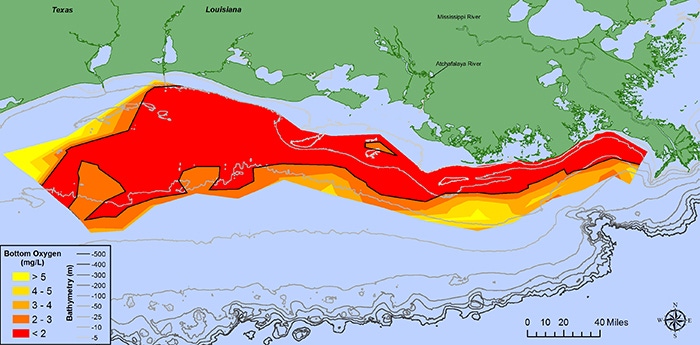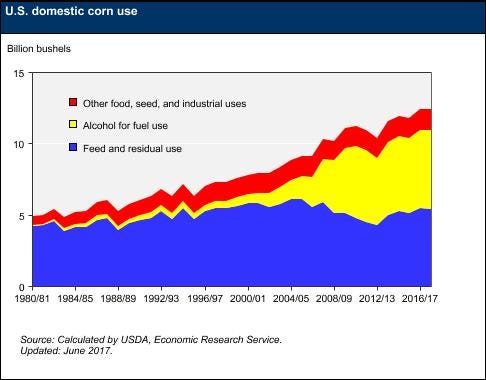Mighty Earth blamed the largest Gulf of Mexico dead zone on the meat industry. Tyson Foods named as biggest influencer.
August 4, 2017

America’s meat processors were pinned as the top companies responsible for the Gulf of Mexico “dead zone” according to a non-governmental organization, Mighty Earth’s recently released report.
Every August scientists measure the size of the Gulf of Mexico “dead zone,” an area of low oxygen that can kill fish and marine life. This year National Oceanic and Atmospheric Administration researchers determine the dead zone is 8,776 square miles, an area about the size of New Jersey.
The annual forecast, generated from a suite of NOAA-sponsored models, is based on nutrient runoff data from the U.S. Geological Survey. These nutrients stimulate massive algal growth that eventually decomposes, using up the oxygen needed to support life in the Gulf.
Scientists anticipated a larger dead zone this year due to the heavy spring rains. “We expected one of the largest zones ever recorded because the Mississippi River discharge levels, and the May data indicated a high delivery of nutrients during this critical month which stimulates the mid-summer dead zone,” says Nancy Rabalais, a research professor at Louisiana State University, who led the survey mission.
The hypoxic zone or dead zone in the Gulf of Mexico forms every summer and is a result of excess nutrients from the Mississippi River and seasonal stratification (layering) of waters in the Gulf. According to the U.S. Environmental Protection Agency, nutrients can come from many sources, including fertilizers from agriculture, golf courses and suburban lawns; erosion of soil full of nutrients; discharges from sewage treatment plants and deposition of atmospheric nitrogen.
Right before NOAA announces the size of this year’s dead zone was the largest since 1985, the environmental activists group deems companies- such as Tyson and Smithfield — as “responsible for the widespread manure and fertilizer pollution contaminating water from the Heartland to the Gulf of Mexico.” Using mapping technology and USGS data, Mighty Earth links the meat processors to the region of the United States with the highest levels of nitrate contamination. According to the report, Tyson and Smithfield are responsible for the Gulf of Mexico dead zone because the company has the most meat processing facilities located in the same geographic location as the majority of farmland, raising grain for livestock feed and biofuels.
Mighty Earth believes the best way to reduce contamination is to name names and cited Arkansas-based Tyson Foods as the top influencer for having processing facilities in each of the states listed by the USGS as contributing the highest levels of pollution to the Gulf of Mexico.
In response to the report, a Tyson spokesperson says “We don’t agree with this group’s characterization of our company but share its interest in protecting the environment. That’s why we publicly disclose our environmental efforts and recently announced that we’re collaborating with the World Resources Institute to develop goals for improving our environmental footprint.”
Despite nutrient loads in the Mississippi River watershed coming from different point and non-point sources, Mighty Earth holds the meat industry accountable for the Gulf of Mexico dead zone.
However, the report fails to mention:
Crops are raised for multiple uses — livestock feed, biofuels and human consumption. While livestock feed accounts for top corn and soybean usage, over 40% of the corn is used for ethanol. Biodiesel consumption in 2015 required production use of 5 billion pounds of soybean oil, or the oil from 441 million soybean bushels. Source: USDA

The pork industry is making great strides. A 50-year comparison of the carbon footprint and resource use for the swine herd, the 50 Year Look back, the pork industry has reduced its carbon, water and land footprint. It has improved our feed conversion ratio by 33%. “In short, the U.S. pork industry uses less feed and less land to produce a pound of pork today than we did 50 years ago. If folks are doing land conversion (taking out prairie ground and forests) it isn’t to grow more feed for the pig industry,” states Allan Stokes, National Pork Board director of environmental programs. Source: National Pork Board
Livestock producers are great recyclers. Distillers grains are byproducts of ethanol and biofuels production and are not produced to feed livestock. The amount of ethanol and biofuels produced are a result of federal legislation and associated regulation (renewable fuels standard) that requires a certain percentage of the fuels produced in the United States be derived from “renewable” sources — which has generally been from corn-based ethanol. The amount of corn and beans that are produced for the purpose of producing biofuels will remain the same unless Congress and EPA alter the RFS. “The fact that livestock producers can and do use distillers grains as a feed source actually serves to ‘recycle’ what would otherwise be a wasted byproduct and further lessens the amount of ground corn producers would otherwise use to feed their livestock. If livestock producers quit feeding DDGS the amount of corn raised for ethanol production would not go down, and the amount of corn used for feeding their animals would increase somewhat,” notes Stokes. Source: National Pork Board
Zero discharge standards for livestock producers. The majority of states have requirements that concentrated animal feeding operations have manure nutrient management plans in place and follow them. These plans require testing of nutrient levels in soil and manure and limiting manure application to agronomic levels appropriate to the crop to be produced. These plans also place setback limits from surface water sources, drainage tile intakes, neighboring property lines and public places governing where manure may be applied. These are specifically set to protect water sources from potential runoff. Similar plans are generally not required for land application of commercial fertilizers. And, unlike municipal wastewater treatment plants that are actually permitted by federal and state agencies to directly discharge levels of nutrients into surface waters, livestock producers are held to a zero discharge standard. Source: National Pork Board
The environment is important to farmers, ranchers and agribusinesses like Tyson. Farmers and ranchers are using formal nutrient management plans every day on the farm to properly restore essential nutrients to the soil by utilizing manure from livestock farms or commercial fertilizer. Farmers are committed to keeping nutrients on the fields. Each state is leading efforts in keeping the nutrients for the crop.
You May Also Like



